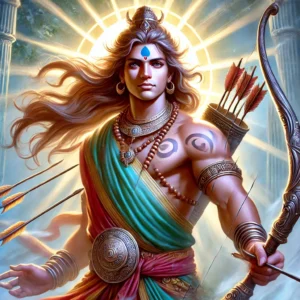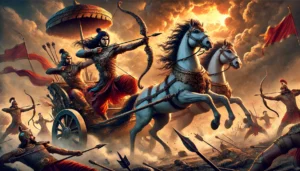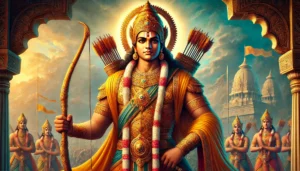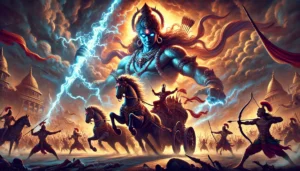
Legend of Barbarika in Mahabharata
Barbarika: The All-Seeing Warrior
The Indian epic Mahabharata is renowned for its intricate narratives and profound characters, each contributing uniquely to the overarching themes of dharma, karma, and the complexities of human life. Among these legendary figures is Barbarika, the grandson of Bhima, whose story, though lesser-known, holds deep philosophical and spiritual significance. Barbarika’s extraordinary abilities and his potential to alter the fate of the Kurukshetra war in a single day make his tale one of the most compelling in the epic.
The Birth and Early Life of Barbarika
Barbarika was born to Ghatotkacha, the powerful son of Bhima and Hidimbi, and Mauravi, a princess of the nagas. His unique parentage blessed him with immense strength and supernatural abilities. From a young age, Barbarika exhibited extraordinary prowess in combat and an innate sense of justice. His character was a blend of his father’s demonic strength and his grandfather Bhima’s righteous spirit.
Barbarika’s early life was marked by rigorous training in the arts of war and devotion to the goddess Kamakhya. Pleased with his devotion and determination, the goddess bestowed upon him three divine arrows, each with unparalleled capabilities.
Table of Contents

Legend of Barbarika in Mahabharata
The Power of the Three Arrows
The three arrows given to Barbarika were not ordinary weapons. Each carried a specific, divine purpose:
The First Arrow: It had the power to mark all objects or beings that Barbarika intended to destroy.
The Second Arrow: It marked all those Barbarika wished to spare.
The Third Arrow: Once released, it would unfailingly target and annihilate all the beings marked for destruction by the first arrow, sparing the rest, no matter where they were.
This incredible weaponry rendered Barbarika virtually invincible. He could decimate entire armies or spare them with precise control, making him a force to be reckoned with.
The Dilemma of Participation in the Kurukshetra War
As the Mahabharata’s climactic war at Kurukshetra loomed, Barbarika, following his principle of supporting the weaker side, resolved to join the battle. However, this noble intention posed a significant philosophical dilemma. Given his unmatched power, whichever side he chose to support would immediately become the stronger side, prompting him to switch allegiances. This cycle could perpetually shift the balance of power, creating an unending war.
Krishna, the supreme strategist and avatar of Lord Vishnu, aware of this potential paradox, decided to intervene. Disguised as a Brahmin, Krishna approached Barbarika to test his intentions and to guide the course of destiny.
The Divine Encounter with Krishna
In their conversation, Krishna questioned Barbarika about his commitment and the use of his powers. Barbarika, with humility and clarity, explained his principle of supporting the weaker side and demonstrated the power of his three arrows. Krishna, realizing the magnitude of Barbarika’s power, understood that his participation would disrupt the divine plan of the Kurukshetra war.
To prevent this, Krishna revealed his true form to Barbarika and asked for an extraordinary sacrifice. Krishna requested Barbarika’s head as an offering before the war began, explaining that this act would serve a greater cosmic purpose.

Legend of Barbarika in Mahabharata
The Sacrifice and Vision of the War
Without hesitation, Barbarika agreed to Krishna’s request, embodying the highest form of devotion and selflessness. Even after his head was severed, it remained conscious and aware, a testament to his divine blessings. Barbarika expressed a final wish—to witness the great war. Krishna granted this wish, placing Barbarika’s head atop a hill overlooking the battlefield.
From this vantage point, Barbarika’s head watched the entire Kurukshetra war unfold. This unique position allowed him to observe the complexities, the strategies, the valor, and the ultimate play of divine will that determined the outcome of the war.
The Legacy of Barbarika
The story of Barbarika doesn’t end with his sacrifice. His head, witnessing the entire war, symbolized the ultimate impartial observer, transcending personal biases and attachments. After the war, when the Pandavas sought to understand who was the true hero of the Kurukshetra battle, Barbarika’s head, with its all-seeing vision, attributed the victory to Lord Krishna’s divine intervention and guidance.
Over time, Barbarika came to be worshipped as Khatushyamji, especially in regions of Rajasthan and Gujarat. Devotees revere him as a deity who grants boons and blessings, embodying the virtues of sacrifice, devotion, and the supremacy of divine will.
Lessons from Barbarika’s Tale
Barbarika’s story imparts profound lessons. It teaches us about the moral complexities of war, the ethical dilemmas of power, and the importance of humility and devotion. His willingness to sacrifice his life for the greater good exemplifies the highest ideals of dharma. Moreover, his role as an impartial observer underscores the notion that true victory in life and war comes not merely from strength or strategy but from aligning with cosmic justice and divine will.
In the vast narrative of the Mahabharata, Barbarika’s tale stands as a luminous testament to the enduring values of selflessness, righteousness, and the ultimate triumph of dharma. His story continues to inspire and guide devotees, reminding us of the profound truth that the greatest warriors are not those who wield the most powerful weapons, but those who understand and uphold the deeper laws of life and destiny.

Legend of Barbarika in Mahabharata
FAQs on “Barbarika: The Omniscient Warrior of Mahabharata”:
- Who is Barbarika?
Barbarika, also known as Khatushyamji, is a fascinating character in the Mahabharata, often overshadowed by more prominent figures like Krishna, Arjuna, and Karna. He was the son of Ghatotkacha (the son of Bhima) and Maurvi (the daughter of the demon Muru). Despite his limited role in the epic, Barbarika is revered in certain traditions for his extraordinary powers and moral commitment.
- What makes Barbarika unique in the Mahabharata?
Barbarika is distinguished by his unwavering devotion, immense power, and the possession of three miraculous arrows. His commitment to justice and fairness, combined with his unparalleled archery skills, make him a unique figure. His ability to switch sides based on which was weaker, out of his sense of fairness, marked him as a warrior with a deeply ethical approach to conflict.
- What are the powers of Barbarika’s three arrows?
Barbarika’s three arrows were gifted to him after years of penance and rigorous training. They were not ordinary arrows:
First Arrow: This arrow had the power to mark all the enemies that needed to be destroyed.
Second Arrow: This arrow could mark all the allies that needed to be protected.
Third Arrow: This arrow would follow the instructions of the first two, destroying all enemies and sparing all allies, making his victory certain with just these three arrows.
- Why did Barbarika not participate in the Mahabharata war?
Despite being ready to participate, Barbarika’s unique condition of siding with the weaker party posed a problem. His shifting allegiance would constantly alter the balance of power, potentially dragging the war endlessly. To prevent this dilemma, Lord Krishna, understanding the potential chaos Barbarika could cause, sought his head as a sacrifice.
- What is the story of Barbarika’s sacrifice?
Krishna, in the guise of a Brahmin, approached Barbarika and asked for his head as a sacrifice. Recognizing Krishna’s divine purpose and the necessity for balance in the war, Barbarika willingly offered his head. As a final wish, he asked to observe the war, which Krishna granted by placing his head on a hilltop, allowing him to witness the entire battle of Kurukshetra.
- What role did Barbarika play after his sacrifice?
After his sacrifice, Barbarika’s head was positioned on a hill overlooking the battlefield, giving him a panoramic view of the Mahabharata war. This act allowed him to fulfill his desire to witness the great war. His impartial view of the events further emphasized the themes of sacrifice and destiny that run throughout the Mahabharata.
- Why is Barbarika worshipped as Khatushyamji?
After the war, Krishna declared that Barbarika’s sacrifice and devotion would be remembered and honored in the Kali Yuga. He blessed Barbarika, granting him the name “Shyam,” a synonym for Krishna himself. Today, Barbarika is worshipped as Khatushyamji, believed to fulfill the wishes of his devotees, offering hope, guidance, and blessings.
- Where is the main temple of Khatushyamji located?
The main temple of Khatushyamji is located in the village of Khatu in the Sikar district of Rajasthan, India. This temple is a major pilgrimage site where thousands of devotees gather, especially during the Phalgun Mela, to seek blessings and honor Barbarika’s memory.
- What is the significance of the Khatushyamji temple?
The Khatushyamji temple is not just a religious site but a symbol of devotion and sacrifice. The temple is known for its serene atmosphere and the deeply spiritual experiences it offers to its visitors. Devotees come from all over India to pray, perform rituals, and participate in the grand celebrations, especially during the Phalgun Mela.
- What lessons can be learned from Barbarika’s story?
Barbarika’s life teaches several profound lessons:
Sacrifice: His willingness to sacrifice for the greater good demonstrates the importance of selflessness.
Devotion: His devotion to Krishna and his moral principles highlight the value of faith and integrity.
Fairness and Justice: His intent to always support the weaker side reflects a deep commitment to fairness and justice.
Understanding the Bigger Picture: His story emphasizes the importance of understanding and acting for the greater good, even at personal cost.
- What festivals or celebrations are dedicated to Barbarika?
The most prominent celebration dedicated to Khatushyamji is the Phalgun Mela, held annually in February-March. This festival draws large crowds of devotees who gather to celebrate and honor Khatushyamji. The event includes religious ceremonies, prayers, and various cultural activities. The mela is a vibrant expression of devotion and community spirit.
- How is Barbarika’s legacy preserved in modern times?
Barbarika’s legacy lives on through the worship of Khatushyamji. The Khatushyamji temple serves as a focal point for this devotion, attracting pilgrims year-round. His story is passed down through generations, often recounted in folk tales, songs, and religious discourses. The annual Phalgun Mela keeps his memory alive, celebrating his virtues of sacrifice, fairness, and devotion.
- How does Barbarika’s story connect with the larger narrative of the Mahabharata?
Barbarika’s story serves as a crucial subplot in the Mahabharata, highlighting the complexities of dharma (duty) and the consequences of one’s actions. His tale underscores the themes of sacrifice and the moral dilemmas faced by the characters in the epic. His sacrifice ultimately helps maintain the balance of power and ensures the war reaches its destined conclusion.
- Are there any other legends or folklore associated with Barbarika?
Apart from the Mahabharata, Barbarika’s story has evolved into various legends and folklore, particularly in regions where he is worshipped as Khatushyamji. These stories often focus on his miracles, his role as a protector of devotees, and his divine interventions in times of need. His association with fulfilling the wishes of his followers adds a mystical dimension to his legacy.
These FAQs provide a deeper understanding of Barbarika’s character, his significance in the Mahabharata, and his enduring legacy as Khatushyamji. His story is a rich blend of devotion, sacrifice, and divine wisdom, resonating with timeless moral and spiritual lessons.
Summary
“Barbarika: The Omniscient Warrior of Mahabharata” explores the lesser-known tale of Barbarika, a powerful warrior in the Indian epic, the Mahabharata. Barbarika, the grandson of Bhima and son of Ghatotkacha, was known for his extraordinary prowess in battle, primarily due to his three infallible arrows, gifted by Lord Shiva. Each arrow had the power to target all enemies, ensure only the guilty were harmed, and return to the quiver after fulfilling its mission.
Barbarika’s unparalleled strength and knowledge of warfare posed a unique challenge. He vowed to support the weaker side in any conflict, which led to a moral dilemma during the Kurukshetra war. His vow could have caused constant shifts in the balance of power, prolonging the war indefinitely.
To prevent this, Lord Krishna, in the guise of a Brahmin, tested Barbarika’s commitment and later revealed his true identity. Krishna explained the potential consequences of Barbarika’s involvement and sought his head as a sacrifice. Understanding the greater good, Barbarika willingly offered his head, which was later placed atop a hill to observe the entire battle. His sacrifice ensured the war reached its destined conclusion without unnecessary prolongation.
Barbarika is revered as a symbol of selflessness and divine insight, embodying the virtues of detachment and dedication to dharma (righteousness). His story emphasizes the importance of wisdom, sacrifice, and the complexities of moral decisions in the face of duty.
Related Articles
- Restful Nights: Ayurvedic Remedies and Traditional Indian Practices to Overcome Insomnia and Late-Night Habits
- The Tridevi: Lakshmi, Saraswati, and Parvati – Their Roles and Powers
- “Divine Creatures of Ancient Indian Scriptures: Exploring the Role of Animals in the Vedas, Puranas, and Mahabharata”
- Nature and Spirituality: Exploring the Sacred Essence of the Himalayas, Ganga, and Other Natural Wonders”
- “Reviving the Gurukul System: Relevance and Lessons for Modern Education”
- “Exploring Greek and Indian Mythology: Similarities Between Greek and Indian Mythology “
- “Embracing Sattvic Living: Harmonizing Mind, Body, and Soul Through Food and Lifestyle”
- “Charity and Prosperity: Exploring the Concept of Daan and Its Financial Relevance in Modern Life”
- How to Build an Eco-Friendly Home Inspired by Vastu Shastra
- Comparison of Ancient and Modern Sports: How Traditional Sports Have Influenced Contemporary Games
- “Timeless Lessons from Ancient Tales: Linking Samudra Manthan and Ganga’s Descent to Modern Ecological Challenges”
- “Reviving Sanskrit: How AI is Preserving Ancient Languages for the Future”
- “Mathura: The Sacred Land of Lord Krishna’s Divine Leelas”
- Investing for Future Generations: Lessons from Indian Traditions on Legacy Building and Wealth Preservation
- “Ancient Indian Wisdom: Timeless Lessons for Tackling Today’s Climate Crisis”
- “Artificial Intelligence and Spirituality: Transforming Ancient Practices for the Modern World”
- “Gold and Real Estate in India: Timeless Assets Shaping Financial Strategies”
- Tradition Meets Innovation: The Evolution of Technology in Hindu Rituals
- End-of-World Myths: Exploring Kali Yuga in Hinduism and Ragnarök in Norse Mythology
- Garuda, Pegasus, and Dragons: The Universal Ties of Mythical Beasts Across Cultures
- “Ancient Vimanas: Mythical Flying Machines or Evidence of Advanced Technology?”
- Time Travel in Hindu Mythology: The Fascinating Tales of Kakudmi and King Raivata
- “Divine Feminine Power in Hindu Mythology: The Legends of Durga, Saraswati, and Lakshmi”
- “Divine Beings of Sanatan Dharma: The Spiritual Significance of Sacred Animals in Hinduism”
- “Symbolism in Mythological Art: Unlocking Hidden Meanings in Ancient Temple Carvings”
- “Exploring Technological Advancements in Ancient India and Civilizations: Vimana, Metallurgy, & Water Management systems”
- Unveiling the Mysteries: Ancient Temples of Sanatan Dharma , Mysterious Temples of India
- “The Scientific Knowledge of Sanatan Dharma: Ancient Wisdom Meets Modern Science”
- Ancient Indian Sports and Games: Celebrating a Legacy of Skill, Strength & Strategy”
- “Exploring the Cosmic Link: The Connection Between Astronomy and Vedic Astrology”
- The Power of Sanskrit: Unlocking the Divine Language of the Gods
- “The End of Kaliyuga: A Sanatan Insight into the World’s Final Chapter”
- Explore more articles on Prachin Sanatan Yuga.

